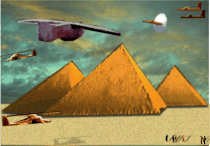Dinosaurs in Literature, Art & History
Song Dynasty (China, 960-1279 A.D.)Ceratopsian? .. Page 34

Ceratopsians were supposed to have died out millions of years ago, but from the number we have found in ancient art as shown on these pages, they were around much more recently than that.
Does this look like a ceratopsian dinosaur? We think so, but make up your own mind.


"Charles Lang Freer bought this sculpture in 1913 with complete confidence in the inscribed date of 1091.
A decade later, the Freer Gallery's first director, John Ellerton Lodge, mused that the piece seemed "crude and not so early."
In the 1960s the sculpture was reevaluated and the date of 1091 was confirmed by relating the sculpture to similar works in Chinese and foreign collections". Smithsonian Freer Gallery..
Introduction to the Ceratopsians
"The oldest ceratopsians appeared at the beginning of the Cretaceous, about 140 million years ago. In the Late Cretaceous, about 100 million years ago, the ceratopsians began to diversify in North America and in Asia.
Forms without the enormous horns and frills of Triceratops, in the family Protoceratopsidae, include the Mongolian genus Protoceratops and the unusual bipedal, frill-less dinosaur Psittacosaurus ("parrot-lizard")....
.... The huge, heavy "frill" of ceratopsians such as Triceratops may have served as armor against the attacks of saurischian predators like Tyrannosaurus, which lived in the same time and place as Triceratops.
However, other ceratopsians had smaller frills and/or frills with large openings; such frills would have been little defense against a predator.
So ceratopsian frills may also have functioned as heat radiators, or signaling devices, or to attract mates, in addition to whatever protective function they may or may not have had". Source: Carroll, R.L. 1988. Vertebrate Paleontology and Evolution.

Click and drag photo to resize.>


Click and drag photo to resize.


1, 2, 3, 4, 5, 6, 7, 8, 9, 10
11, 12, 13, 14, 15, 16
17 18, 19,
20,
21,
22,
23,
24,
25,
26,
27,
28,
29,
30,
31,
32,
33,
34,
35,
36,
37,
38,
39,
40,
41,
42,
43,
44,
45,
46,
47
Next>>>


 Home
Home 20th Century Dinosaurs
20th Century Dinosaurs Dinosaurs in Literature, Art & History
Dinosaurs in Literature, Art & History Eyewitness Accounts
Eyewitness Accounts There Were Giants In The Earth in Those Days
There Were Giants In The Earth in Those Days Mega Fauna
Mega Fauna Those Sophisticated "Cave Men"
Those Sophisticated "Cave Men" Search for Noah's Ark
Search for Noah's Ark DNA, The Ultimate Oopart
DNA, The Ultimate Oopart The Bone Yards
The Bone Yards Underwater Cities, Monuments?
Underwater Cities, Monuments? Ancient Atomic Knowledge?
Ancient Atomic Knowledge? Salvation. What Must You Do To Be Saved?
Salvation. What Must You Do To Be Saved? Search
Search Links
Links Guestbook
Guestbook


